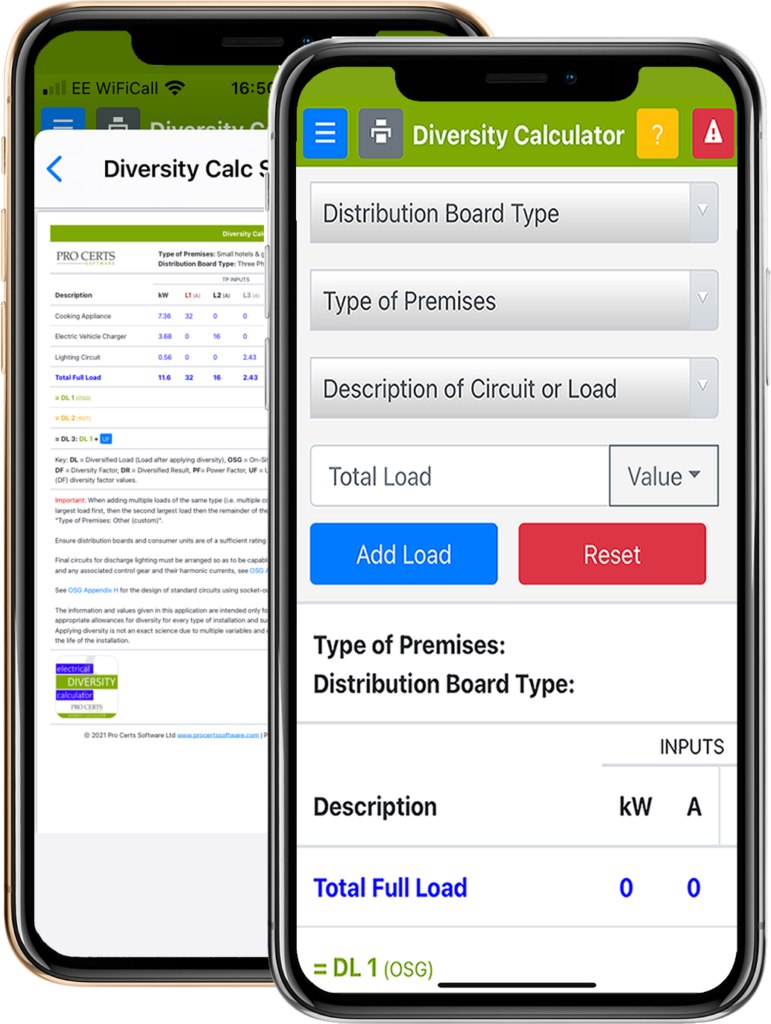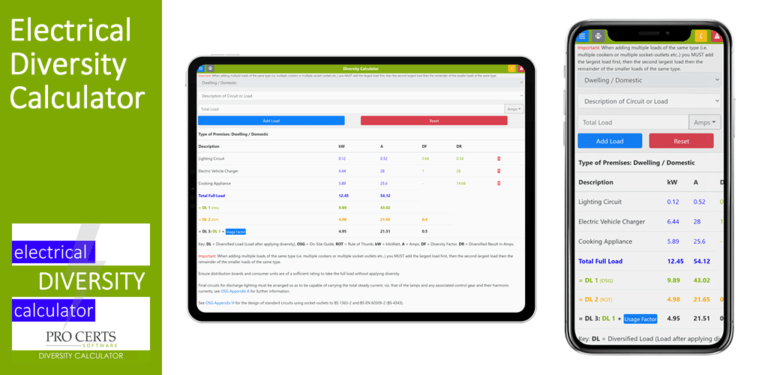Maximum Demand Calculator
Calculating the maximum demand and the total connected load can be daunting and confusing, until now, try using our new web based electrical diversity calculation software which is included within our cloud based online electrical software.
This maximum demand calculator will calculate the maximum demand for single phase and three phase loads from the total connected load and apply diversity using three different methods with the option to apply an additional usage factor (UF) to the diversified load (DL 1)
Methods of Calculating Maximum Demand
- On-Site Guide Appendix A
- Rule of Thumb Method
- Custom Method
- Apply Optional Additional Usage Factor (UF)
- Max Demand Calculation Software
On-Site Guide Appendix A
BS7671 On Site Guide Appendix A – Maximum demand and diversity: Appendix A sets outs the demand to be assumed and factors to be applied to the total connected load for calculating the maximum demand.
The On-Site Guide (BS 7671:2018+A2:2022) can be purchased directly from → BSI On-Site Guide or → Amazon On-Site Guide.
Table A1
Table A1 details current demand to be assumed for points of utilization and current-using equipment.
Table A2
Table A2 includes allowances for diversity such as lighting circuits, cooking appliances like cookers, electric heating & socket-outlets etc.
This method is indicated by DL 1 (OSG) within the maximum demand calculation software.
Rule of Thumb Method
Calculating electrical diversity rule of thumb method: This method uses a basic rule of thumb method (ROT) depending on the type of premises.
This method is the least accurate of methods because it assumes a single diversity factor for the entire total connected load, also each and every electrical installation and how that electrical installation is utilised are always different.
This method is similar to how the DNO may sometimes (or sometimes used to) calculate the maximum demand for the supply to new installations.
Type of Premises
- Dwelling / Domestic: 0.4 (40%)
- Small shops & offices: 0.8 (80%)
- Small hotels & guest houses: 0.6 (60%)
This method is indicated by DL 2 (ROT) with the maximum demand software.
Custom Method
Calculating maximum demand Custom method: This method is the most accurate method for calculating the maximum demand of electrical installations, distribution boards and final circuits, assuming it is carried out correctly and thoroughly.
Although this is the most accurate method for calculating the maximum demand, it is also the hardest and most time consuming method.
When using this method you can enter your own diversity factor for each load for the maximum demand calculation.
This method is identified as DL (custom) within the electrical maximum demand calculation software.
Usage Factor (UF)
If required you may apply an additional Usage Factor to the DL 1 diversified load calculation which will apply a further overall diversity factor to the diversified maximum demand load (DL 1) result.
Maximum Demand Calculations
Maximum demand results:
- DL 1 (OSG) = Based on BS 7671 Appendix A of the On-Site Guide.
- DL 1 (Custom) = Based on your own diversity factor values.
- DL 2 (ROT) = Based on the ROT (Rule of Thumb) method.
- DL 3 = DL 1 x UF (Custom Usage Factor).
Allowances for Maximum Demand
Allowances for the application of diversity and maximum demand calculations call for special knowledge and experience. Applying diversity is not an exact science and no single formula or maximum demand allowance will apply to each electrical installation due to multiple variables, scenarios and circumstances.
Electrical Maximum Demand Calculator Download Links
Check out our web based online Maximum Demand Calculator, or download our standalone Electrical Diversity Calculator app.

Download The App!
Maximum Demand Calculator, calculate the total connected load and apply diversity.
For further information visit Maximum Demand Calculator.
Or, get the cloud desktop version →








